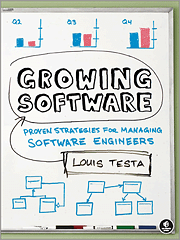|

|
This is a terrific reminder of the breadth and skills needed when taking on the role of CTO in a small company. The book really sticks to its agenda, and goes through project management, quality assurance, process improvement, assessment of what is already in place when you arrive, recruitment and managerial politics.
It is easy to read, flowing at a good pace and with lists of key points, some good diagrams, and entertaining half-page quotes from people who have been in particular situations. There's an excellent diagram explaining the misunderstandings that may arise in product features between customers, engineers and marketing staff. The cost-benefit analysis of project tasks being prioritised, and also the impact analysis of bug reports, are both great. Since we'll always be asked to do more than we have time for, this framework for justifying prioritisation will help other managers to understand and express what matters.
Each chapter is long enough to give you an understanding of any topics you may not already have known, but no single topic takes over the book. The excellent references include Peopleware, The Mythical Man Month and User Interface Design for Programmers, as well as Wikipedia and some recent publications. Much of the book will be familiar to an experienced team lead, but by going over each topic from the beginning, it gives you a solid foundation in them all. As it says in the last chapter, "If you have read straight through this book, you have covered a lot of ground."
The underlying principle of the book, in addressing a person newly hired to be the CTO of a 50-person software company, is that you should first review the position you're in. Consider business issues architecture, quality, personalities and strategy as well as features. Then write some notes before acting. This comes across repeatedly in talk of process improvement, long term plans and quality time bombs, amongst many other areas.
Although rich in truthiness, with many points I can confirm from my own experience, there were a couple of small errors (which didn't detract significantly). A list of factors motivating engineers is rather short (Fred Brookes has the proper list), a calculation of productive hours in a day is done backwards, and a chart is described as having information that it hasn't. Despite reading two chapters on product roadmaps, I found it was still unclear how to match technical requirements to the market. Recruitment is covered in depth (recommending day-long interviews) but it doesn't lead on to the full costs of inducting new staff into a team.
Because the reader is likely to be highly familiar with their own technology, but may be new to senior management politics, the book spends quite a lot of time on soft skills. Some of this, like recruitment, may in fact already be known, but some, like making sure that the engineering department remains close to the marketing department, is very pertinent.
I wholeheartedly recommend Growing Software. I found it reassuring on those topics already within my experience, and enlightening on the areas beyond. It is never patronising, and has none of the padding that so many 400 page books have. I look forward to more, both by the author and from this publisher.
Contents * Introduction * Part I: Development Team o 1. Getting Started (understanding the people in the company you have joined) o 2. Managing a Development Team (trust, communication, conflict resolution) o 3. Creating an Effective Development Team (efficiency, office space, communicating with other teams) o 4. Growing a Software Team (recruitment) * Part II: Product and Technology o 5. Defining the Product (prototyping, building a relationship with Marketing) o 6. Driving Releases (scheduling, release process, version numbers) o 7. Evaluating your Tools and Methods (backups, documentation, version control, bug tracking ...) o 8. Assessing your Technology (quality of the existing scalability, error reporting, third part libraries, ...) * Part III: Outside of Engineering o 9. Working with Your Company (culture, inter-team problems, peer relationships, team respect) o 10. Working with the CEO and the Executive Team (supporting your boss, collaborating effectively) o 11. Listening to Your Customers (customer satisfaction, closing the deal ...) * Part IV: Making Work Flow: Projects, Process and Quality o 12. Project Estimating (task list, writing an estimate, overheads) o 13. Starting a Project (assembling the team, timeline, project plan) o 14. Project Execution and Tracking (Gannt charts, tracking spreadsheets, risk, changes) o 15. Designing a Software Development Process (waterfall, iterative, agile processes, customising, introducing) o 16. Process Improvement (listing process steps, estimating times, analysing a model) o 17. Understanding Quality Assurance (valuing quality, QA tools and environment, defect ranking, metrics) * Part V: Planning the Future o 18. Setting the Direction (listen to the market, create a whole product, technology overhauls) o 19. Product Roadmap and Strategy (creating a roadmap, cost-benefit calculations) o 20. Going Forward (summary of principles) * Appendix o A. Software Company Structure (organisation charts, and staff roles for various sizes of company) o B. Internationalisation (translation, databases, currency, dimensions, QA, translation companies) o C. Corporate Workflow Diagram (mapping the actions in a process, with department interactions) * Index
